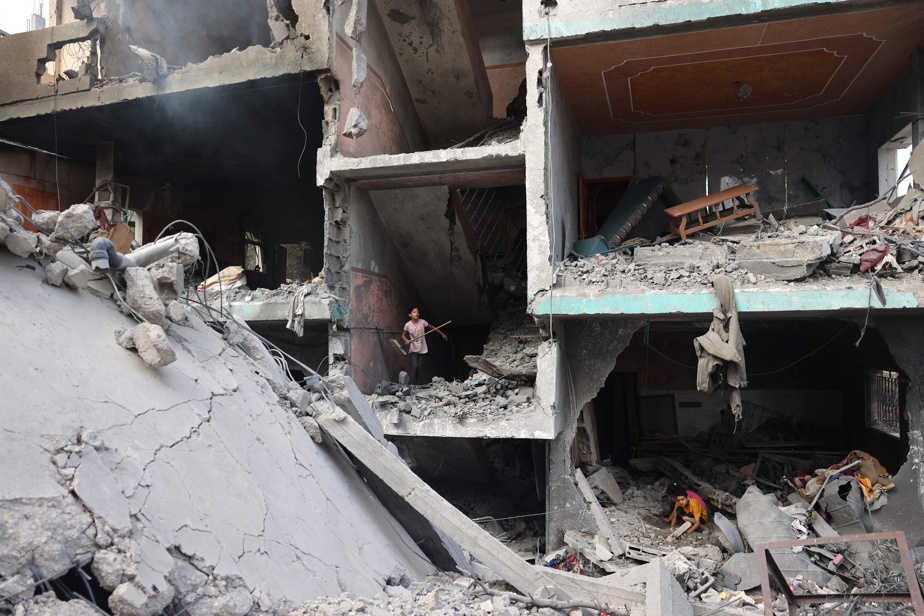US Secretary of State Antony Blinken returned to the Middle East on Monday to promote a ceasefire in the Gaza Strip, which is being bombarded again by the Israeli army after more than eight months of war against Hamas in the Palestinian territory.
Arriving in Cairo, Mr. Blinken is due to meet Egyptian President Abdel Fattah al-Sissi before going to Israel for talks with Prime Minister Benjamin Netanyahu.

PHOTO SAUL LOEB, ASSOCIATED PRESS
US Secretary of State Antony Blinken
Diplomatic negotiations intensified on Monday, with the United States, Israel’s main ally, increasing pressure for a truce with a request for a vote in the UN Security Council calling on Israel and Hamas to silence the guns.
The war launched on October 7 by Israel after a bloody attack by Hamas on Israeli territory left tens of thousands dead, ravaged a large part of the Gaza Strip and uprooted most of its 2.4 million inhabitants facing at risk of starvation.
The besieged Palestinian territory experienced a particularly deadly weekend, after an Israeli special forces operation freed four hostages – a woman and three men – in Nusseirat, in the center of the Gaza Strip.
Divisions in Israel
The Hamas health ministry in the besieged Palestinian territory said 274 people were killed and 698 injured Saturday in Nusseirat, denouncing a “massacre” in a densely populated area of the Gaza Strip. This assessment could not be independently verified.
The release of the four hostages was welcomed with joy in Israel and reinforced Mr. Netanyahu in his military strategy. But it did not prevent the resignation on Sunday of the war cabinet of minister without portfolio Benny Gantz, who demands the adoption of a post-war “action plan”.
Mr. Gantz’s departure does not immediately upset Mr. Netanyahu’s government coalition, which still has a majority in Parliament with the support of far-right groups. This departure, however, reflects growing divisions over how to fight Hamas, the Palestinian Islamist movement which took power in Gaza in 2007.
For Mr. Gantz, the priority is to obtain the release of the hostages while Mr. Netanyahu says he wants to continue the war until the destruction of Hamas, considered a terrorist organization by Israel, the United States and the European Union. .
Multiple keystrokes
Operations by the Israeli army continued on Sunday and Monday morning, including a strike on a house in Gaza City that killed five people, including an eight-month pregnant woman, during the night, an official told AFP. spokesperson for Civil Defense.
During the night, Israeli warships targeted the coast of Gaza City, reported an AFP correspondent on the spot.
Also in the north, an Israeli strike killed two people in a house in Choujaiya, according to al-Ahli hospital. Israeli artillery also targeted houses in Tal al-Hawa, southwest of Gaza City, and Zeitoun, to the southeast, according to the AFP correspondent.
In the south of the territory, witnesses reported artillery fire north of Rafah, with Civil Defense reporting deaths and injuries. And in the center, Israeli aircraft carried out a strike on Deir al-Balah, while artillery fire was heard east of the city, where witnesses said they saw the bodies of people killed after clashes.
Still in the south, violent fighting is taking place in the city center of Rafah, according to witnesses. “The situation is very difficult in the al-Mawasi area […]what is happening is very dangerous, the occupier is shooting at places that were supposed to be safe,” Mahdi Zouroub, 35, told AFP.
In just over eight months of war, at least 37,124 Palestinians have been killed, mostly civilians, in the Gaza Strip, according to data from the Health Ministry of the Hamas-led Gaza government.
The Hamas attack on October 7 in Israel resulted in the deaths of 1,194 people, the majority civilians, according to an AFP count based on official Israeli data. During this attack, 251 people were taken as hostages. Among them, 116 hostages are still being held in the Gaza Strip, of whom 41 are dead, according to the Israeli army.
“Immediate and complete”
On the diplomatic front, the vote in the UN Security Council on the text supporting the plan unveiled at the end of May by American President Joe Biden is planned for Monday, according to diplomatic sources, but has not been confirmed by the South Korean presidency of the Council.
According to the third version seen by AFP, the text provides for a first phase with an “immediate and complete” ceasefire, release of hostages taken by Hamas and “exchange” of Palestinian prisoners, withdrawal of the Israeli army “populated areas of Gaza”, and entry of humanitarian aid.
If this phase takes more than six weeks, the ceasefire will be maintained “as long as negotiations continue”.
